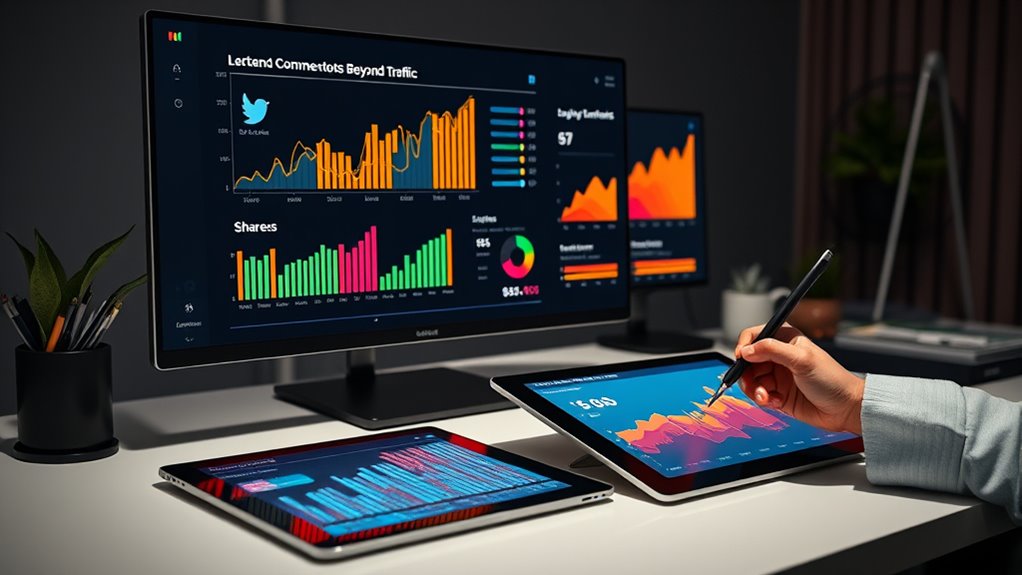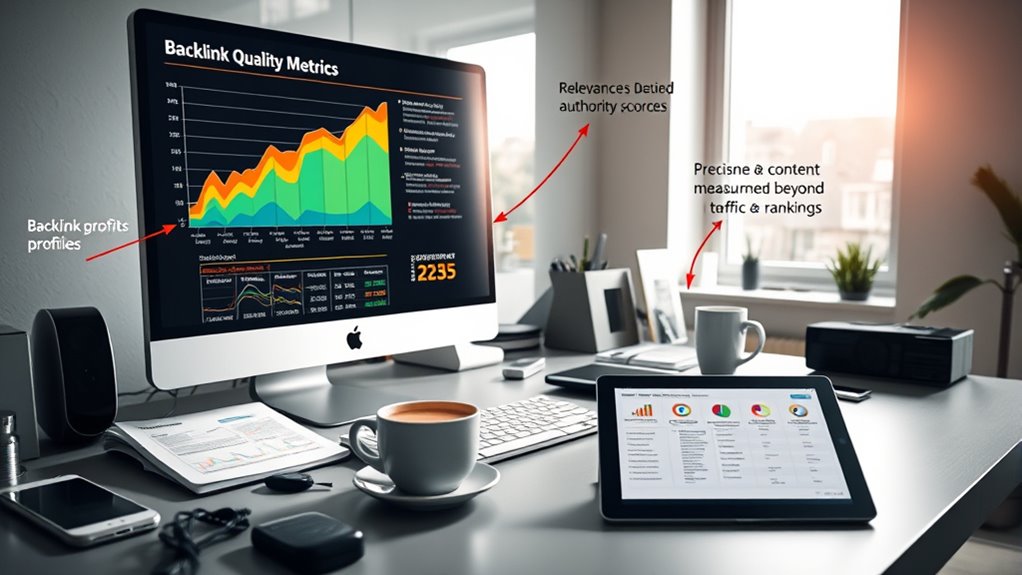To measure your content authority beyond traffic and rankings, focus on audience engagement metrics like comments, shares, and time on page, which show how well your content resonates. Evaluate backlink quality from reputable sources, and look for positive brand mentions and social proof. Pay attention to how well your content aligns with user intent and the presence of trust signals like endorsements and certifications. Keep exploring, and you’ll uncover even more ways to gauge your true influence.
Key Takeaways
- Engagement metrics like comments, shares, and time on page reveal audience interest and content relevance beyond rankings.
- Backlink quality and external recognition from industry experts bolster content authority and credibility.
- Brand mentions, social proof, and influencer endorsements reflect public trust and reputation.
- Content depth, clarity, and alignment with user intent demonstrate authority and user satisfaction.
- Trust signals such as certifications, badges, and technical site factors reinforce perceived reliability and expertise.
Engagement Metrics That Reflect Audience Interaction

Engagement metrics are essential indicators of how your audience interacts with your content. One key metric is interactive polls, which invite your audience to voice opinions directly, revealing their preferences and interests. These polls boost engagement and provide immediate feedback on what resonates. Comment sentiment is another crucial metric; analyzing the tone and emotions expressed in comments helps you gauge how your audience feels about your content. Positive comments indicate strong approval, while negative or neutral sentiments highlight areas needing improvement. Combining these metrics offers a clearer picture of audience engagement beyond simple views or shares. Additionally, understanding audience preferences related to specific topics can help you tailor your content more effectively. Recognizing how well-being tips are received can guide the creation of more relevant and impactful content. Staying informed about industry trends allows you to adapt your approach and maintain content relevance. By paying close attention to interactive polls and comment sentiment, you can tailor your content to better meet your audience’s expectations, ultimately enhancing your content’s authority and relevance. Incorporating insights from content engagement metrics can also inform your overall content strategy and improve audience retention. Moreover, tracking mental health benefits associated with different topics can help you create content that resonates on a deeper level.
Quality and Relevance of Backlinks

How do you determine the true authority of your content? Focus on backlink quality and relevance. High-quality backlinks come from sites with strong domain authority, signaling trustworthiness and authority. Relevance matters too—links from related topics boost your content’s credibility more than unrelated ones. To evaluate backlinks, consider these factors:
| Backlink Source | Domain Authority | Relevance to Content |
|---|---|---|
| Industry Blog | High | Highly relevant |
| Local Directory | Moderate | Slightly relevant |
| Unrelated Site | Low | Not relevant |
Prioritize backlinks from reputable sources in your niche. This improves your content’s perceived authority, making your site more trustworthy and influential in your industry. Additionally, understanding the business landscape can help identify authoritative sources that align with your niche and enhance your backlink profile. Recognizing the diversity of backlinks ensures a more natural and effective link profile, boosting overall content credibility. Paying attention to backlink relevance is crucial for establishing genuine authority and avoiding spammy link building practices. Incorporating AI-driven analysis can further refine your backlink strategy by identifying emerging authoritative sources and spotting potential vulnerabilities in your link profile. Moreover, assessing the quality of backlinks helps ensure that your link profile remains robust and trustworthy over time.
Brand Mentions and Social Proof

Have you ever noticed how brand mentions and social proof can influence your perception of a company’s credibility? When others talk about a brand positively across social media, reviews, or news outlets, it boosts its reputation and trustworthiness. These mentions serve as social proof, signaling to you that the brand is reputable and reliable. They also help establish authority beyond just website traffic or rankings, reflecting real-world validation. Monitoring brand mentions across platforms allows you to gauge public sentiment and identify influencers who can enhance your credibility. Strong, consistent social proof can differentiate your content and build authority in your niche. Additionally, incorporating wall organization systems and stylish decor solutions into your content strategy can enhance your brand’s visual appeal and credibility. By tracking how often and where your brand is mentioned, you gain valuable insights into your overall brand reputation and perceived authority. Recognizing the impact of visual elements such as decor and organization can further reinforce your brand’s credibility and appeal. Furthermore, understanding how brands like Patchology establish trustworthiness through certifications and endorsements from beauty experts can provide valuable lessons for building your own authority. Moreover, aligning your content with principles of home organization can foster a stronger connection with your audience seeking practical and trustworthy solutions.
User Intent and Content Alignment

To measure your content’s authority, you need to understand how well it matches user intent. Focus on keyword relevance, ensuring your content addresses what your audience is searching for, and make it clear and exhaustive. Keep an eye on engagement signals like click-through rates and time on page to see if your content truly resonates. Incorporating insights from glycolic acid benefits, such as its role in exfoliation and skin improvement, can help align your content with what users seek in skincare topics. Additionally, assessing how your content aligns with mindset principles for success can enhance its perceived authority and relevance to your audience. Paying attention to sound recording techniques can also inform content strategies for multimedia topics, ensuring your material remains authoritative and comprehensive. Understanding content optimization strategies can further refine your approach to meet evolving search engine criteria and user expectations, especially by integrating relationship insights to better address emotional and personality-related queries.
Keyword Relevance Alignment
Are your content and keywords truly aligned with user intent? Ensuring keyword relevance involves more than matching exact phrases; it requires integrating semantic keywords that reflect the broader context of user searches. When your content maintains strong topic consistency, it signals to search engines that your page thoroughly addresses the query’s intent. This alignment helps your content resonate with users’ expectations and reduces bounce rates. Focus on selecting keywords that naturally fit within the overall theme, rather than isolated keywords that don’t support the bigger picture. By emphasizing semantic keywords and maintaining topic consistency, you create a cohesive experience that demonstrates authority and relevance, ultimately boosting your chances of ranking higher for the right searches. Additionally, understanding ice cream flavors and ingredients can help tailor your content to match specific user interests and queries. Ensuring your site’s security vulnerabilities and compliance are addressed also builds trust with users and search engines alike. Recognizing the importance of emotional support in content can further strengthen your content’s impact and authority. Incorporating content quality metrics such as readability and engagement can also enhance your overall content strategy and demonstrate your expertise. Paying attention to dream symbols and their meanings can provide deeper insights into your audience’s subconscious interests, enriching your content’s relevance and emotional connection.
Content Depth & Clarity
How well does your content meet user intent? To evaluate this, focus on your content structure and readability. A well-organized content structure guides your readers naturally through your message, ensuring they find the information they seek without confusion. Clarity is key—use simple language and clear explanations to address user questions directly. When your content aligns with user intent, it demonstrates depth and understanding, showing that you’ve thought about what your audience needs. Improving readability involves breaking up complex ideas, using headings, bullet points, and concise sentences. This makes your content accessible, engaging, and easy to scan. Incorporating sound healing science principles can also enhance the perceived authority and credibility of your content. Additionally, aligning your content with interior decor themes can further demonstrate your expertise in creating inviting and cohesive spaces, fostering trust with your audience. Considering entertainment venue schedules, such as theme parks and amusement parks, ensures that your content provides practical, up-to-date information that directly meets user needs.
User Engagement Signals
Understanding user engagement signals is essential because they reveal how well your content aligns with what your audience is seeking. When your content matches user intent, visitors stay longer, interact more, and return. Content freshness influences engagement, especially for trending topics and timely information. Technical SEO ensures your site loads quickly and is easy to navigate, boosting user satisfaction. Consider how these signals reflect content alignment:
| Engagement Metric | Focus Area | Impact |
|---|---|---|
| Bounce Rate | User intent | Indicates mismatch or relevance issues |
| Time on Page | Content quality | Longer suggests valuable content |
| Click-Through Rate | Content relevance | Higher shows alignment with search intent |
| Return Visits | Content freshness | Recurring visitors imply ongoing relevance |
Content Sharing and Virality

What drives certain content to go viral while others fade into obscurity? It’s often viral sharing that propels content into the spotlight, creating rapid content amplification. When your content resonates emotionally or offers unique value, people are more likely to share it across social media platforms and communities. Analyzing sharing patterns helps you understand what fuels virality and how your audience engages beyond mere views. Metrics like share counts, referral traffic, and social media mentions reveal how effectively your content spreads. High viral sharing indicates strong relevance and appeal, boosting your authority through increased visibility. By focusing on content that encourages sharing, you can harness the power of virality to amplify your reach and establish your credibility in your niche.
Trust Signals and Expert Endorsements

Trust signals like authority badges and certifications can instantly boost your content’s credibility. When experts or influencers endorse your work, it signals to your audience that your content is trustworthy. These endorsements and recognitions are powerful tools to establish and measure your authority.
Authority Badges and Certifications
Have you ever noticed the badges or certifications displayed on a website or online profile? These authority badges serve as trust signals, boosting your perception of a site’s credibility. They’re a form of badges recognition that quickly communicates expertise and reliability. When you see certifications from reputable organizations, you’re more likely to trust the content and consider the source authoritative. These visual cues help differentiate credible sites from less trustworthy ones. Here’s a quick look at common authority badges:
| Badge Type | Recognized Certifying Body | Purpose |
|---|---|---|
| Google Partner | Digital marketing credibility | |
| BBB Accreditation | Better Business Bureau | Business trustworthiness |
| ISO Certification | ISO | Quality management standards |
| SSL Certificate | Certificate Authority | Security and data protection |
| Industry Awards | Various industry bodies | Industry recognition |
Such badges reinforce your content’s authority beyond rankings.
Influencer and Expert Endorsements
Ever wonder why endorsements from influencers and industry experts boost a website’s credibility so effectively? These peer validation signals demonstrate industry recognition, showing that respected voices vouch for your content. When influencers or experts endorse your site, it signals to search engines and users alike that your content is trustworthy and authoritative. Such endorsements act as powerful trust signals, helping you stand out amid competition. They also enhance your reputation within your niche, making your content more appealing to both audiences and search algorithms. By securing industry recognition through expert praise, you build a reputation grounded in credibility. This form of validation encourages higher engagement, increases sharing, and ultimately improves your content’s perceived authority beyond simple traffic metrics.
Frequently Asked Questions
How Can Content Authority Influence Conversion Rates?
Content authority impacts your conversion rates by building trust and credibility with your audience. When you engage in guest blogging and focus on backlink quality, you enhance your site’s authority. This makes visitors more likely to trust your content, products, or services, leading to higher conversions. Strong authority signals reassure prospects, making them more comfortable taking the desired actions, whether it’s making a purchase or subscribing to your newsletter.
What Role Does Content Freshness Play in Authority Measurement?
You might think fresh content is just for SEO, but it actually impacts your authority measurement considerably. The truth is, content freshness counters content decay, ensuring your site stays relevant. The relevance lifespan of your content influences how authoritative your site appears over time. Regular updates boost engagement and signal to search engines that your content remains valuable, helping you maintain or grow your content authority beyond just traffic and rankings.
How Do Niche-Specific Metrics Differ From General Authority Metrics?
When you consider niche-specific metrics versus general authority metrics, you focus on niche relevance and specialized metrics tailored to your industry. Unlike broad metrics like traffic and rankings, niche metrics assess factors like domain expertise, community engagement, and content accuracy. You’ll find these metrics provide a more precise picture of your authority within your specific field, helping you identify strengths and areas for improvement that general metrics might overlook.
Can User-Generated Content Impact Perceived Content Authority?
Did you know that 86% of consumers say authenticity influences their purchasing decisions? User-generated content profoundly impacts perceived content authority by boosting content authenticity, which strengthens your brand reputation. When users share genuine experiences, it makes your content more trustworthy, leading to higher credibility. So, yes, user-generated content plays an essential role in shaping how your audience perceives your authority and the overall strength of your brand.
What Are Emerging Tools for Assessing Content Credibility Beyond Traditional Metrics?
When evaluating content credibility, you shouldn’t rely solely on traditional metrics. Emerging tools now focus on content authenticity and source verification, helping you assess whether information is trustworthy. For example, fact-checking platforms and AI-powered verification tools analyze data origins and consistency. These innovations enable you to go beyond basic traffic and rankings, ensuring you’re using genuinely credible content and maintaining your audience’s trust.
Conclusion
So, after all, measuring content authority isn’t just about traffic or rankings. Ironically, the real signals lie in how your audience interacts, shares, and endorses your content—things you often overlook chasing numbers. Don’t forget, backlinks and mentions are just shiny trophies; true authority comes from genuine trust and relevance. So, next time you obsess over metrics, remember: the most meaningful ones are often the ones you can’t easily quantify.









